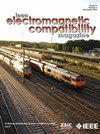倾斜闪电通道情况下LEMP波形对电离层反射高度的估计
IF 2
3区 计算机科学
Q3 ENGINEERING, ELECTRICAL & ELECTRONIC
IEEE Transactions on Electromagnetic Compatibility
Pub Date : 2024-12-03
DOI:10.1109/TEMC.2024.3502457
引用次数: 0
摘要
雷电电磁脉冲与电离层的相互作用通常采用时域有限差分法在二维柱坐标系或二维球坐标系下进行分析。本文给出了三维球坐标系下电场和磁场的时间更新方程,并计算了从垂直或倾斜闪电回击通道的底部出发,在地球曲面上很远的距离上的垂直电场。雷电通道用修正的电流随通道距离线性衰减的输电在线模型来表示。采用Heidler函数表示的上升时间为3 μs的通道基电流波形。电离层用电导率随高度呈指数增长的非均匀介质模拟。视电离层反射高度是根据地波和第一天波到达的时间差估计的。将地波和天波的到达时间定义为其场峰的到达时间时,电离层反射高度的估计取决于信道倾角,并随着场观测距离的增加而增加。将地波和天波到达时间定义为其场导数峰的80%到达时间时,估计的电离层反射高度受距离和信道倾角的影响不大。本文章由计算机程序翻译,如有差异,请以英文原文为准。
Estimation of Apparent Ionospheric Reflection Height from LEMP Waveforms for the Case of Tilted Lightning Channel
The interaction of lightning electromagnetic pulse with the ionosphere has been often analyzed using the finite-difference time-domain method in the 2-D cylindrical coordinate system or in the 2-D spherical coordinate system. In this article, time-update equations for electric and magnetic fields in the 3-D spherical coordinate system are presented, and vertical electric fields at far distances over the curved surface of the Earth from the base of a vertical or tilted lightning return-stroke channel are computed. The lightning channel is represented by the modified transmission-line model with linear current decay with the distance along the channel. A realistic channel-base current waveform with a risetime of 3 μs represented by the Heidler function is used. The ionosphere is simulated by a nonuniform medium whose conductivity increases exponentially with altitude. Apparent ionospheric reflection heights are estimated based on the arrival time difference between the ground wave and the first skywave. When the arrival times of ground wave and skywave are defined as the arrival times of their field peaks, the estimated ionospheric reflection height depends on channel tilt angle and increases with increasing field observation distance. In contrast, when the arrival times of ground wave and skywave are defined as the arrival times of 80% of their field derivative peaks, the estimated ionospheric reflection height is not much influenced by either distance or channel tilt angle.
求助全文
通过发布文献求助,成功后即可免费获取论文全文。
去求助
来源期刊
CiteScore
4.80
自引率
19.00%
发文量
235
审稿时长
2.3 months
期刊介绍:
IEEE Transactions on Electromagnetic Compatibility publishes original and significant contributions related to all disciplines of electromagnetic compatibility (EMC) and relevant methods to predict, assess and prevent electromagnetic interference (EMI) and increase device/product immunity. The scope of the publication includes, but is not limited to Electromagnetic Environments; Interference Control; EMC and EMI Modeling; High Power Electromagnetics; EMC Standards, Methods of EMC Measurements; Computational Electromagnetics and Signal and Power Integrity, as applied or directly related to Electromagnetic Compatibility problems; Transmission Lines; Electrostatic Discharge and Lightning Effects; EMC in Wireless and Optical Technologies; EMC in Printed Circuit Board and System Design.

 求助内容:
求助内容: 应助结果提醒方式:
应助结果提醒方式:


